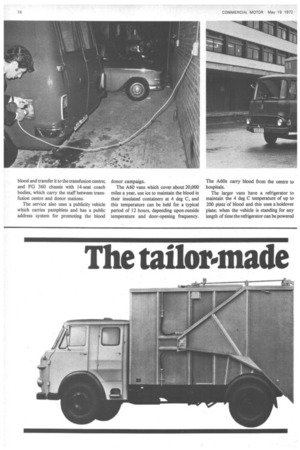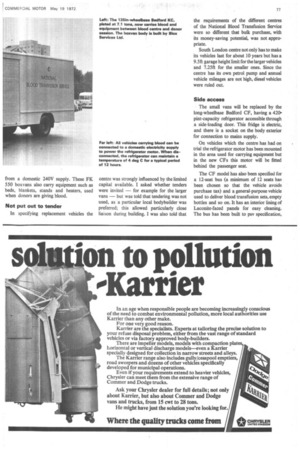Vehicles that save lives
Page 77

Page 78

Page 79

Page 80

If you've noticed an error in this article please click here to report it so we can fix it.
A public service whose transport by Trevor Longcroft
works on a tight budget
SOMEONE, somewhere need your blood now. Fine, but how does it get from the donor to the recipient? The answer is that in most cases it travels in special vehicles operated by the regional blood transfusion services and, if the South London centre is anything to go by, those vehicles have to be bought with a sharp eye on initial cost and a long, economical life. The South London blood transfusion centre is responsible for obtaining blood and supplying plasma throughout the South East.
This South London centre recently embarked on a vehicle replacement programme, phasing out the existing fleet of 30 vehicles over a period of perhaps 10 years. Type for type, the new vehicles will be larger, despite the extra cost, not only because of increasing demands on blood transfusion services but also because the slightly higher first cost will be more than outweighed by operating economies through a marked reduction in the number of vehicle journeys required for a given batch of consignments.
The job to be done I discussed the special characteristics demanded of blood transfusion vehicles with Dr K. L. Rogers, regional transfusion director, and Mr R. Bird, principal administrative assistant at the South London centre. Also taking part was Mr H.J. Proctor, contracts director of Blox Services Ltd, of Fountain Road, London SW17, who played a large part in drawing up the specification of the vehicles which they are to supply.
Until now, the fleet has been an all-Austin one, with A60 vans to carry insulated containers having a capacity of 200 pint bottles of blood; FK 550 boxvans for transporting transfusion equipment to and from the donor stations and to store the collected blood and transfer it to the transfusion centre; and FG 360 chassis with 14-seat coach bodies, which carry the staff between transfusion centre and donor stations.
The service also uses a publicity vehicle which carries pamphlets and has a public address system for promoting the blood donor campaign.
The A60 vans which cover about 20,000 miles a year, use ice to maintain the blood in their insulated containers at 4 deg C, and this temperature can be held for a typical period of 12 hours, depending upon outside temperature and door-opening frequency. The A60s carry blood from the centre to hospitals.
The larger vans have a refrigerator to maintain the 4 deg C temperature of up to 200 pints of blood and this uses a holdover plate; when the vehicle is standing for any length of time the refrigerator can be powered from a domestic 240V supply. These FK 550 boxvans also carry equipment such as beds, blankets, stands and heaters, used when donors are giving blood.
Not put out to tender
In specifying replacement vehicles the centre was strongly influenced by the limited capital available. I asked whether tenders were invited — for example for the larger vans — but was told that tendering was not used, as a particular local bodybuilder was preferred; this allowed particularly close liaison during building. I was also told that the requirements of the different centres of the National Blood Transfusion Service were so different that bulk purchase, with its money-saving potential, was not appropriate.
South London centre not only has to make its vehicles last for about 10 years but has a 9.51t garage height limit for the larger vehicles and 7.25ft for the smaller ones. Since the centre has its own petrol pump and annual vehicle mileages are not high, diesel vehicles were ruled out.
Side access
The small vans will be replaced by the long-wheelbase Bedford CF, having a 420pint-capacity refrigerator accessible through a side-loading door. This fridge is electric, and there is a socket on the body exterior for connection to mains supply.
On vehicles which the centre has had on trial the refrigerator motor has been mounted in the area used for carrying equipment but in the new CFs this motor will be fitted behind the passenger seat.
The CF model has also been specified for a 12-seat bus (a minimum of 12 seats has been chosen so that the vehicle avoids purchase tax) and a general-purpose vehicle used to deliver blood transfusion sets, empty bottles and so on. It has an interior lining of Laconite-faced panels for easy cleaning. The bus has been built to psv specification, but I was told that it had not proved so comfortable as had been hoped.
For the two new boxvans required to carry both blood and equipment the centre specified a larger body of higher capacity. The Bedford KC 135in-wheelbase chassis plated for 7.1 tons has been chosen and the complete vehicle weighs less than 3 tons unladen so the driver needs no hgv licence.
The new body houses the 200-bottle refrigerator unit behind the driving compartment, as before, with access from the side of the vehicle and can also carry 6ft 6in beds and other equipment. The final body fitments and the method of stowing will not be settled until a committee, now sitting, has decided the best equipment for use at the donor sessions.
The new fleet will total 10 vehicles —the two big boxvans, three CF buses, two general-purpose vans, two 420-pint blood transporters and a new publicity outfit; the latter is a Land-Rover towing a purposebuilt caravan which will improve the facilities for the staff to address the public and distribute literature.




























































































































